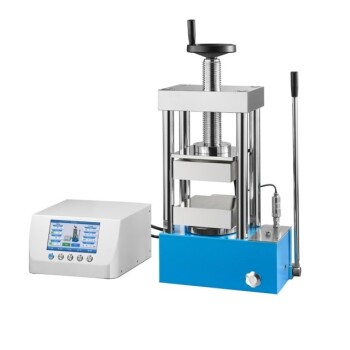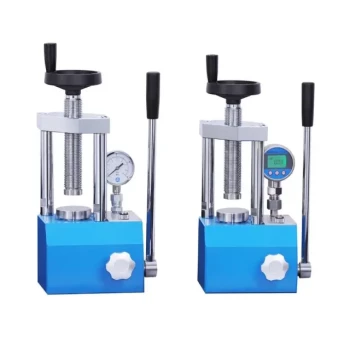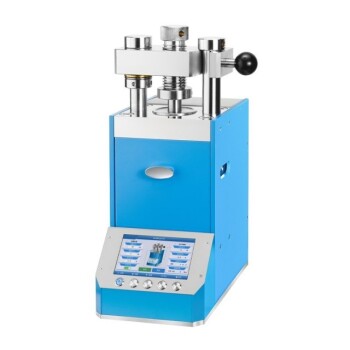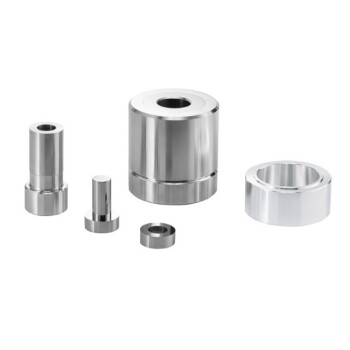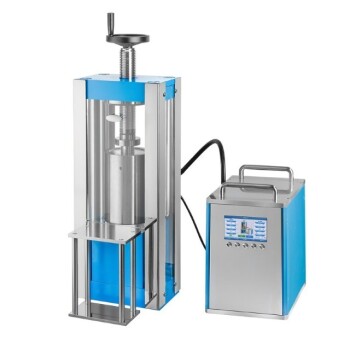In Fourier Transform Infrared (FTIR) spectroscopy, the quality of your data is determined long before the analysis begins. Proper sample preparation is absolutely crucial because it transforms a raw material into a uniform, measurable format. This process ensures the infrared beam can interact with the sample effectively, minimizing spectral distortions and interference to produce an accurate and reliable chemical fingerprint.
The core purpose of sample preparation is to eliminate physical inconsistencies in the sample that can distort the chemical information being measured. While the spectrometer reads the data, it is the physical state of the sample—its particle size, uniformity, and density—that dictates the quality and accuracy of that data.
The Physics of an FTIR Measurement
To understand why preparation is so critical, we must first understand how the instrument "sees" your sample. An FTIR spectrometer works by passing a beam of infrared light through a sample and measuring which frequencies of light are absorbed. These absorptions correspond to the vibrations of chemical bonds, creating a unique spectrum.
The Problem of Scattering and Reflection
When the IR beam encounters large or irregularly shaped particles, the light can scatter in multiple directions instead of passing cleanly through to the detector. This phenomenon, known as Mie scattering, creates a distorted, sloping baseline and can obscure or alter the shape of your absorbance peaks.
Analyzing a coarsely ground powder directly is a common source of this error. The large void spaces and uneven surfaces lead to ineffective and inconsistent interaction between the light and the sample.
The Necessity of Homogeneity
The IR beam samples only a small area. If your sample is not perfectly homogeneous, with the analyte evenly distributed, the measurement will not be representative of the bulk material.
One part of the sample might have a higher concentration than another, leading to spectra that are impossible to reproduce. This is especially critical in quantitative analysis, where accuracy depends on consistent sample composition.
Ensuring Infrared Transparency
For a standard transmission measurement, the IR beam must be able to pass through the sample. If the sample is too thick, too dense, or too concentrated, it will be opaque to the infrared light.
This results in "flat-topped" or totally absorbing peaks, where no light reaches the detector, making the data useless. Proper preparation, such as creating a thin KBr pellet, ensures the sample is dilute and thin enough to allow light to pass through.
The Goal of Common Preparation Techniques
Different preparation methods exist, but they all share the same fundamental goals: reduce particle size, ensure uniformity, and control the sample's thickness and concentration.
The KBr Pellet Method
This classic technique involves grinding a tiny amount of sample with potassium bromide (KBr), an IR-transparent salt, and using a hydraulic press to form a thin, transparent pellet.
This process directly addresses the core problems. Grinding reduces particle size to minimize scattering, mixing with KBr creates a homogeneous solid solution, and the press ensures a consistent thickness and density for a clear measurement.
Attenuated Total Reflectance (ATR)
ATR is a popular alternative that often requires less preparation. The sample is pressed directly against a high-refractive-index crystal (like diamond or germanium). The IR beam reflects internally within the crystal, creating an "evanescent wave" that penetrates a few micrometers into the sample.
Even with ATR, sample preparation is still a factor. Achieving good, consistent contact between the sample and the crystal is paramount for a strong, reproducible signal.
Understanding the Pitfalls and Trade-offs
Errors in FTIR are most often traced back to poor sample preparation, not instrument malfunction. Understanding common mistakes is key to avoiding them.
Inconsistent Grinding and Mixing
If the sample is not ground to a fine powder (smaller than the wavelength of the IR light), scattering will distort the spectrum. Likewise, if it is not mixed thoroughly with the KBr, you will see a non-homogeneous distribution, leading to a non-representative analysis.
The Impact of Pellet Thickness
A pellet that is too thick or too concentrated will block too much light, resulting in poor spectral quality. Conversely, a pellet that is too thin or too dilute will produce a weak signal with a low signal-to-noise ratio. Consistency is the goal.
Contamination from the Binder
KBr is hygroscopic, meaning it readily absorbs water from the atmosphere. If not kept perfectly dry, broad water absorption peaks can overwhelm the sample's spectrum, making interpretation difficult or impossible.
Making the Right Choice for Your Goal
Your preparation strategy should align with your analytical objective. The rigor required for precise quantification is different from that needed for simple material identification.
- If your primary focus is quantitative analysis: You must create highly reproducible samples by meticulously controlling the sample-to-KBr ratio, grinding time, pellet thickness, and compaction pressure.
- If your primary focus is qualitative identification: Speed may be a priority. An ATR accessory is often sufficient, but you must ensure the crystal is clean and that you apply firm, consistent pressure to achieve good contact for a clear spectrum.
- If you are troubleshooting distorted or noisy spectra: Always suspect the sample first. Re-prepare it with a focus on finer grinding, more thorough mixing, and ensuring it is completely dry before suspecting an issue with the instrument itself.
Ultimately, meticulous sample preparation transforms FTIR from a temperamental technique into a powerful, precise analytical tool.
Summary Table:
| Aspect | Importance |
|---|---|
| Particle Size | Reduces scattering for clear spectra |
| Homogeneity | Ensures representative and reproducible analysis |
| Sample Thickness | Prevents light blockage and weak signals |
| Common Methods | KBr pellet and ATR techniques for optimal results |
Enhance your FTIR analysis with KINTEK's reliable lab press machines! Our automatic lab press, isostatic press, and heated lab press ensure uniform sample preparation, reducing errors and improving data accuracy for laboratories. Contact us today to discuss how our solutions can meet your specific needs and boost your analytical efficiency!
Visual Guide
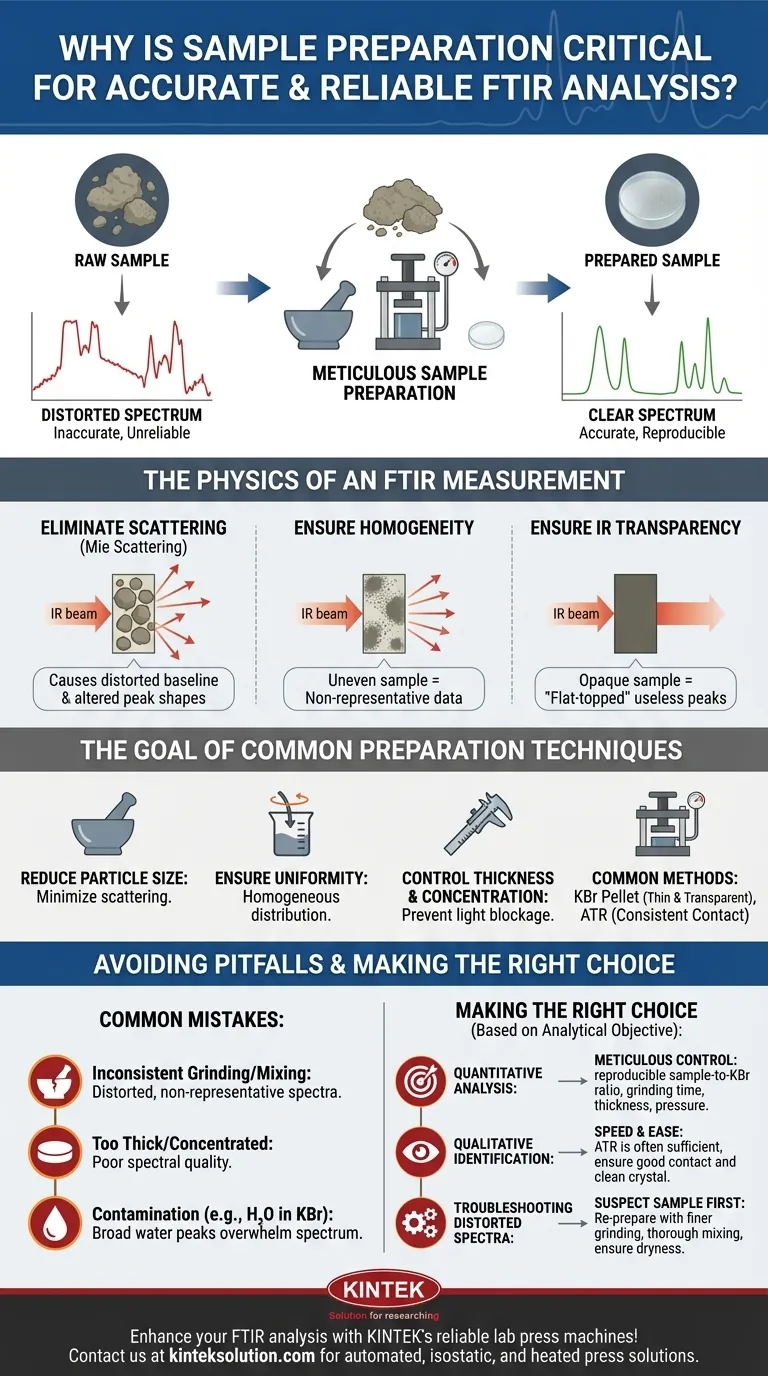
Related Products
- Manual Laboratory Hydraulic Press Lab Pellet Press
- Automatic Laboratory Hydraulic Press Lab Pellet Press Machine
- Automatic Laboratory Hydraulic Press for XRF and KBR Pellet Pressing
- Laboratory Hydraulic Press Lab Pellet Press Button Battery Press
- 24T 30T 60T Heated Hydraulic Lab Press Machine with Hot Plates for Laboratory
People Also Ask
- How are hydraulic presses used in the preparation of powder mixtures? Achieve Precise Compaction for Accurate Analysis
- What is the primary purpose of a manual lab hydraulic pellet press? Ensure Accurate Sample Prep for XRF and FTIR
- What are the key features of manual hydraulic pellet presses? Discover Versatile Lab Solutions for Sample Prep
- What feature of the hydraulic portable press helps monitor the pellet-making process? Discover the Key to Precise Sample Preparation
- How do you operate a manual hydraulic pellet press? Master Precise Sample Preparation for Accurate Analysis




